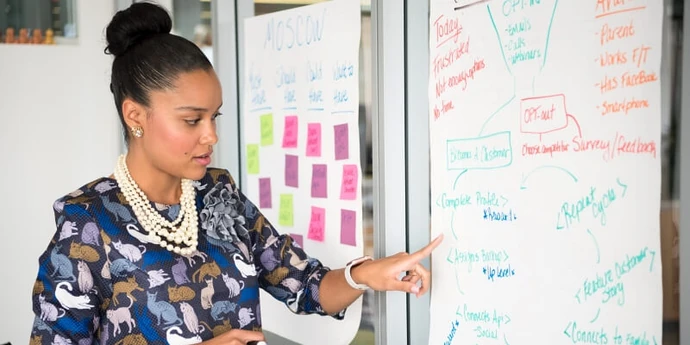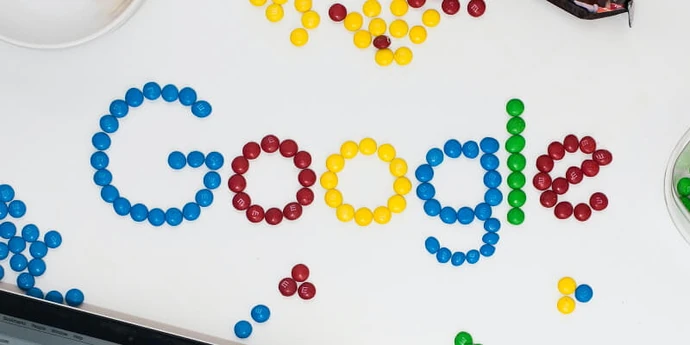Acceptance rates for technical program manager (TPM) jobs at the very top tech companies tend to be under 1%.
As you can imagine, most candidates don’t get past the resume screening.
So if you want to get an interview for a TPM role at Google, Meta, Amazon, or any other big tech company, you’ll need to make sure your resume is in top condition.
That’s why we’ve made this article for you. To prepare it, we asked tech recruiters and TPM coaches for their tips on how to make a resume stand out.
We’ve also gathered REAL EXAMPLES of TPM resumes that have earned candidates offers or interviews at Google, Microsoft, and other top companies.
Whatever your experience level, we're here to help you write the best resume you possibly can.
Here’s an overview of what we’ll cover:
- 8 golden rules for technical program manager resumes
- 7 must-have skills on a technical program manager (TPM) resume
- 5 REAL technical program manager (TPM) resume examples
- Technical program manager resume template
- How to write a technical program manager resume
- Your TPM resume checklist
Let’s get into it.
Get expert feedback on your resume with an ex-FAANG TPM
1. 8 golden rules for technical program manager (TPM) resumes↑
We asked Cody (top tech recruiter, ex-Google now at LinkedIn), Candace (career and resume expert), Kelly (ex-Google/Amazon TPM), Ines (Google program manager), and Javaid (Microsoft Principal TPM) what advice they'd give to someone writing a resume to get into FAANG or similar.
They've helped a LOT of people get into top tech companies, and they evaluate resumes every day, including TPM resumes. They know what they're talking about. This is what they came up with:
Tip #1 Answer recruiters' questions immediately
There is one thing that all recruiters and hiring managers want to know immediately: years of role-relevant experience.
So, make it easy for them.
"Us recruiters are lazy. Don't make us dig around for the key info, we want to see if you meet the job requirements in the first 10 seconds!" says Cody.
Recruiters like Cody and Candace see so many personal statements or 'objective' sections at the top of resumes, which take up valuable space without saying much at all.
Cody’s advice: don’t include vague statements such as 'Experienced technical program manager'.
Instead, use the space for specific information such as your years of experience and the projects you’ve worked on. Include some bullet points with these key pieces of information at the top of your resume.
This leads us to the next point...
Tip #2 Consider a non-traditional structure
The layout we recommend in Section 4 is the traditional one, which is perhaps the safest. But it's not obligatory.
Cody prefers using two bullet-point summaries at the top of your resume to pack in the key information and your most impressive career achievements.
"The top of the resume is the prime real estate. Put the shiny bits, your best achievements, up top. That way, you've got a better chance of grabbing the recruiter's attention."
This is what it looks like on page 1 of his resume:
Click to watch Cody's full explanation of this non-traditional resume format.
Tip #3 Avoid using design features
Using a fancy resume design won't impress recruiters looking for a TPM candidate. And, in a worst-case scenario, it could prevent your resume from being properly processed.
"Design features like pictures, columns, photos, etc., can prevent ATS (applicant tracking systems) from correctly scanning your resume," says Candace.
You should also avoid including your photo in your resume. This goes against employment and discrimination laws in most countries, and is another potential problem for ATS.
You might also want to avoid using multiple-column layouts. Such layouts are a bit of a struggle for some ATS models.
Tip #4 Be explicit about the working arrangements you prefer
So many people fail to do this. But if FAANG recruiters are going to approach you for roles, they'll need to know which working arrangement you’re open to.
Whether you’re okay with a specific location, willing to relocate, open to hybrid, or prefer remote work – make it clear in your resume.
For example, instead of putting "San Francisco" under your name next to your email, maybe you put "Locations: San Francisco | Remote | Hybrid within a 30-mile radius of Bay Area".
Tip #5 Make each bullet point count
When writing your work experience section, don’t just list your tasks. Instead, let your bullet points tell a story of how you’ve made an impact.
When working on each bullet point, Kelly’s advice is to ask the following questions: "Why is this important? What significance or outcome did it have on the business? Whom did I partner with to deliver?"
These questions help ensure your bullet points have enough context and highlight the most relevant work that you did in each role.
To further polish each bullet point, Kelly’s advice is to get rid of any company jargon and acronyms. Make sure recruiters can understand every detail you put in your resume.
Tip #6 Numbers tell a better story
It’s worth repeating this tip: quantify your achievements to show the impact you’ve made in your role.
All the most effective resumes are packed full of metrics and numbers that put achievements in context.
Numbers clearly demonstrate the value you’ve added to an organization.
"Focus on quantifying scale,” Kelly says. “Quantify outcome but don’t miss out on the other details like team size, number of stakeholders, how many transactions, revenue, cost, etc."
Tip #7 Use a skills section to include TPM-relevant keywords
Keyword-stuffing your resume feels like a red flag, but with ATS, you’ll want all the relevant keywords in there.
To avoid jamming your resume with keywords for the sake of ATS, Candace’s advice is to include a skills section. It helps recruiters quickly see if you fit the requirements.
"You could also consider a ‘technology snapshot’ type section if the jobs you’re applying for require experience in specific technologies."
Tip #8 Focus on impact and complexity
When crafting your bullet points, Ines says that it’s better to focus on impact rather than on the result.
Some questions your bullet points need to answer: "Why was the program you worked on important to the business, and why did it deserve to have a TPM allocated to it?"
Ines also stresses the importance of describing the complexity and cross-functional nature of the project you’ve led.
She says, “Tech giants often don't hire TPMs for smaller programs that an Engineering Manager could run themselves. Additionally, they want TPM to be product owners just as much as the EM or PM.”
2. 7 must-have skills on a technical program manager (TPM) resume↑
The job of a technical program manager is quite varied and broad. For the purpose of this resume guide, we’ve identified seven key skills that you’ll want to demonstrate in your resume to show recruiters that you’ve got what it takes.
Depending on the type of technical program manager you want your resume to portray, certain skill areas will be more essential than others.
So, before you start writing, you should first reflect on the type of TPM you are or want to be.
Right, let's take a look at our list of TPM skills.
2.1 Program management skills
This is a given across all technical program manager roles. You’ll need to show you have the skills to execute complex, multi-disciplinary projects, from beginning to end.
This is obviously not one specific skill, but more a wide-ranging skillset. Here are some of the most important components to cover in your resume:
- Use of methodologies such as Agile, Waterfall, etc
- Identifying, assessing, and managing risks
- Prioritizing
- Managing schedules and deadlines
- Allocating resources
- Tracking and reporting progress
2.2 Facilitation skills
As a TPM, one of your responsibilities is helping engineers and other team members progress. You’ll need to clear all obstacles out of their way so they can focus on shipping.
It’s not easy to put this on a resume. To exemplify this skill, devote a bullet point to how you unblocked a project, took preemptive action to avoid a bottleneck, or improved a process.
2.3 Engineering skills of some level
You don’t always need to be highly technical to be a TPM. But you’ll want to show you understand the sorts of problems that engineers face and can discuss technical trade-offs with them.
Some companies will ask for basic coding skills. If you have some, be sure to mention them on your resume.
2.4 System design skills
You need system design skills to discuss engineering architecture and make decisions relating to efficiency, scalability, and performance.
If you have any system design or related experience, make sure it’s prominent on your resume.
2.5 Data analysis skills
As a TPM, you need to define success metrics and make sure goals are achieved. This means being comfortable using data for decision-making in line with business objectives.
You can demonstrate this in your resume by quantifying success on past projects in terms of key metrics.
2.6 Leadership skills
You need to show experience driving projects forward and influencing people you don’t have authority over in order to build a common consensus.
If you haven’t got many strong examples from your work experience, give evidence of leadership in the extracurricular section of your resume.
2.7 Communication skills
Being a TPM requires interfacing with different stakeholders, aligning them, and updating them on project statuses. You’ll need to be as comfortable communicating with executives as you are with engineers.
So, include experience of working with cross-functional teams and partnerships across a company.
Demonstrating these skills on your resume should signal to recruiters and interviewers that you have the right capabilities they're looking for.
For more reading on what it takes to be a technical program manager, we recommend this post by GitHub’s Ben Balter.
3. 5 REAL technical program manager (TPM) resume examples↑
Before we get into how to write your resume, let’s take a look at some real examples that got their owners TPM roles at FAANG and other top companies.
You'll notice they follow different formats, and none fully follow the guidelines we set out below in Section 5. We think this shows two things:
- There are many acceptable ways to write a resume
- Your resume doesn't have to be perfect, as long as it demonstrates your skills and achievements effectively.
Note that we’ve anonymized the following resumes and used pseudonyms to protect our sources’ privacy.
Let's take a look.
3.1 Google technical program manager resume example
This is a resume example that got its owner “Claire,” a TPM interview at Google, which she successfully cleared.
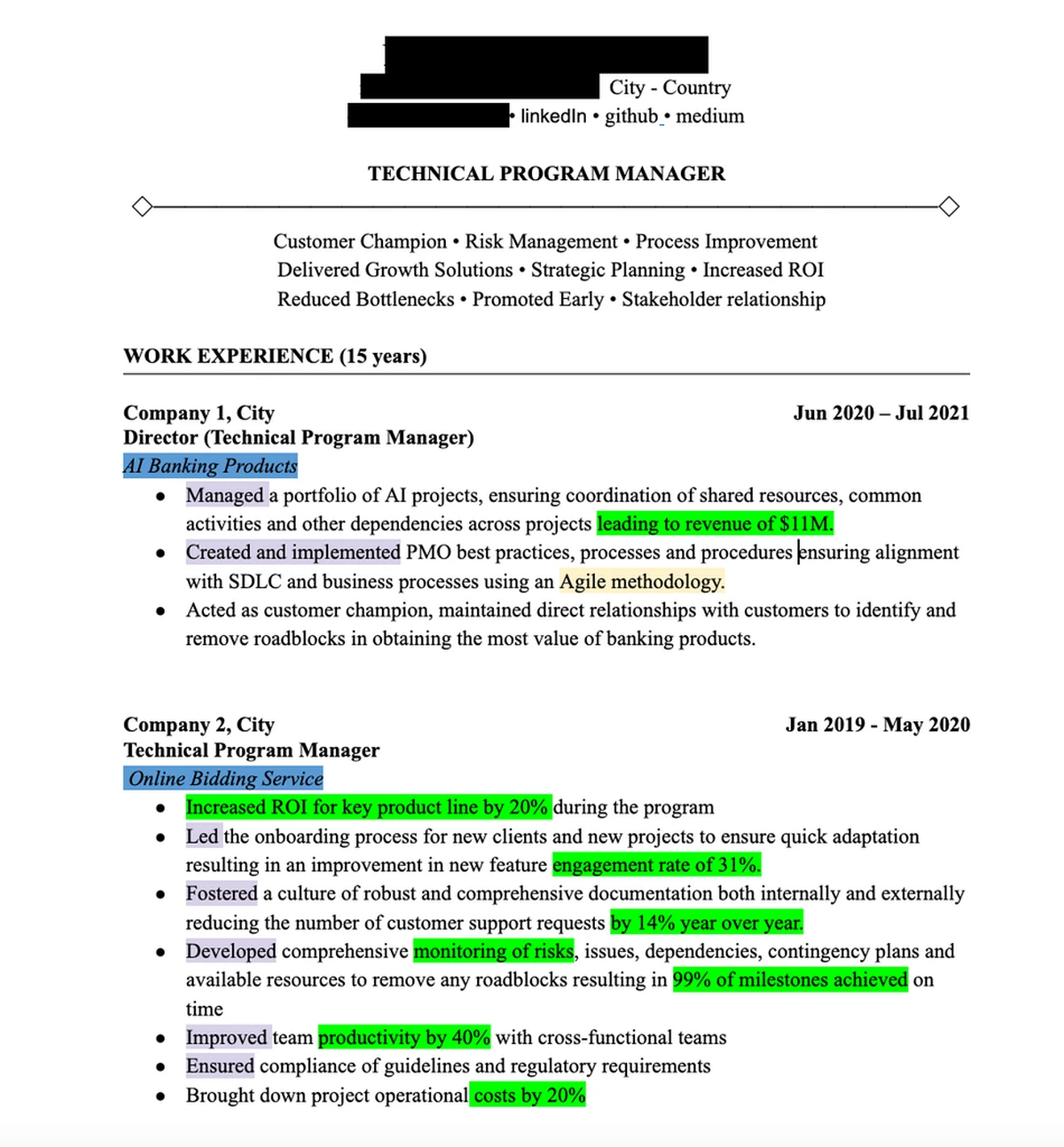
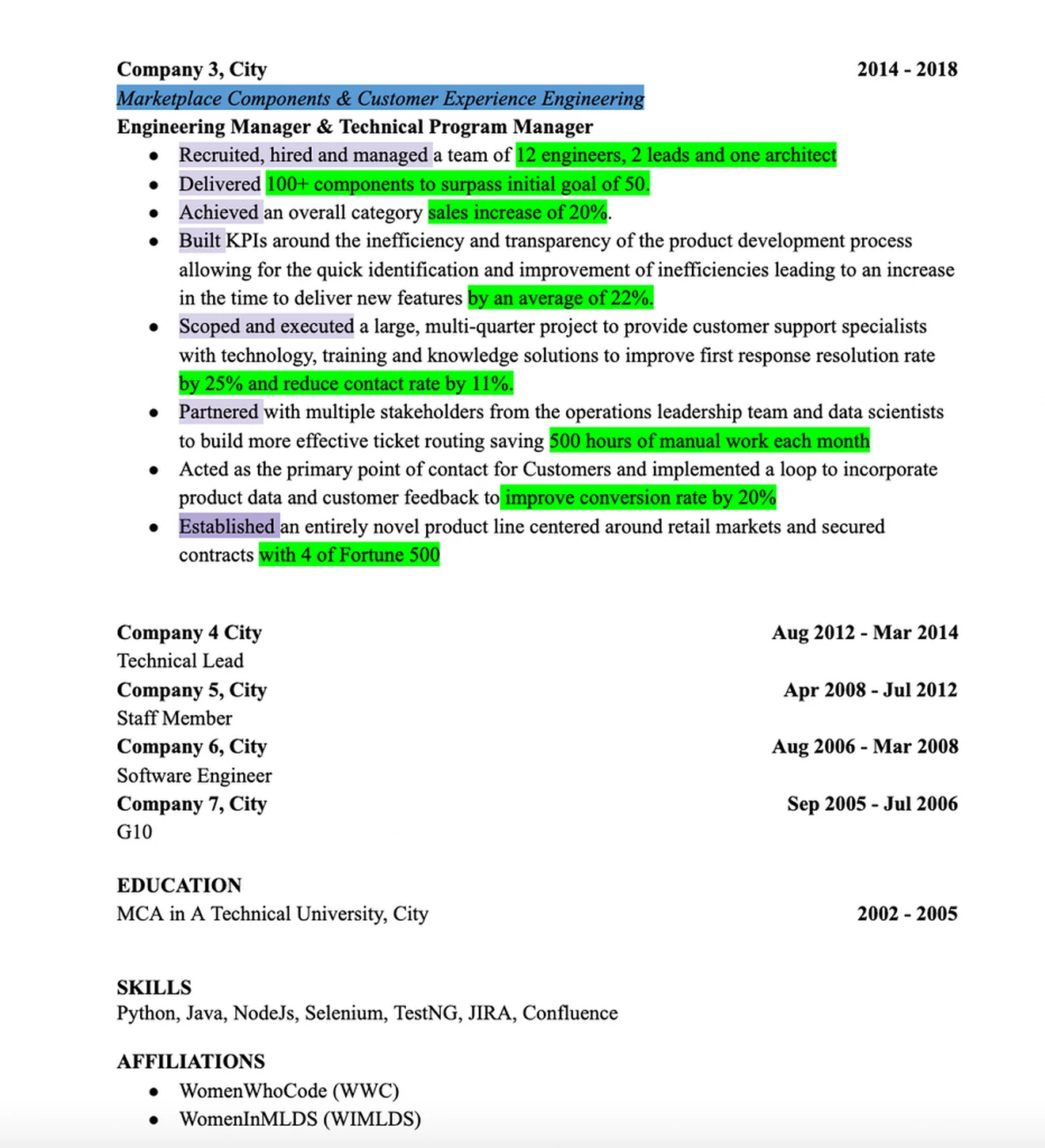
You’ll notice that it’s 3 pages, breaking Google’s advice on length. But what makes this resume stand out is that the candidate communicates her work achievements in a very clear way.
Here are some great practices she employs:
- Quick company intro. Her previous companies may not be well-known to the recruiter, so she adds a brief explanation.
- Action verbs. The candidate starts each sentence with a powerful action verb that reflects key TPM responsibilities and skill areas.
- Quantifying achievements. She provides metrics to make achievements measurable and specific.
- Key skills for the role. Agile methodology was listed in the job description, so the candidate made sure to include it near the top.
3.2 Google technical program manager resume example
Same with the first resume example, this TPM resume got “Greg” an interview invite and job offer at Google.
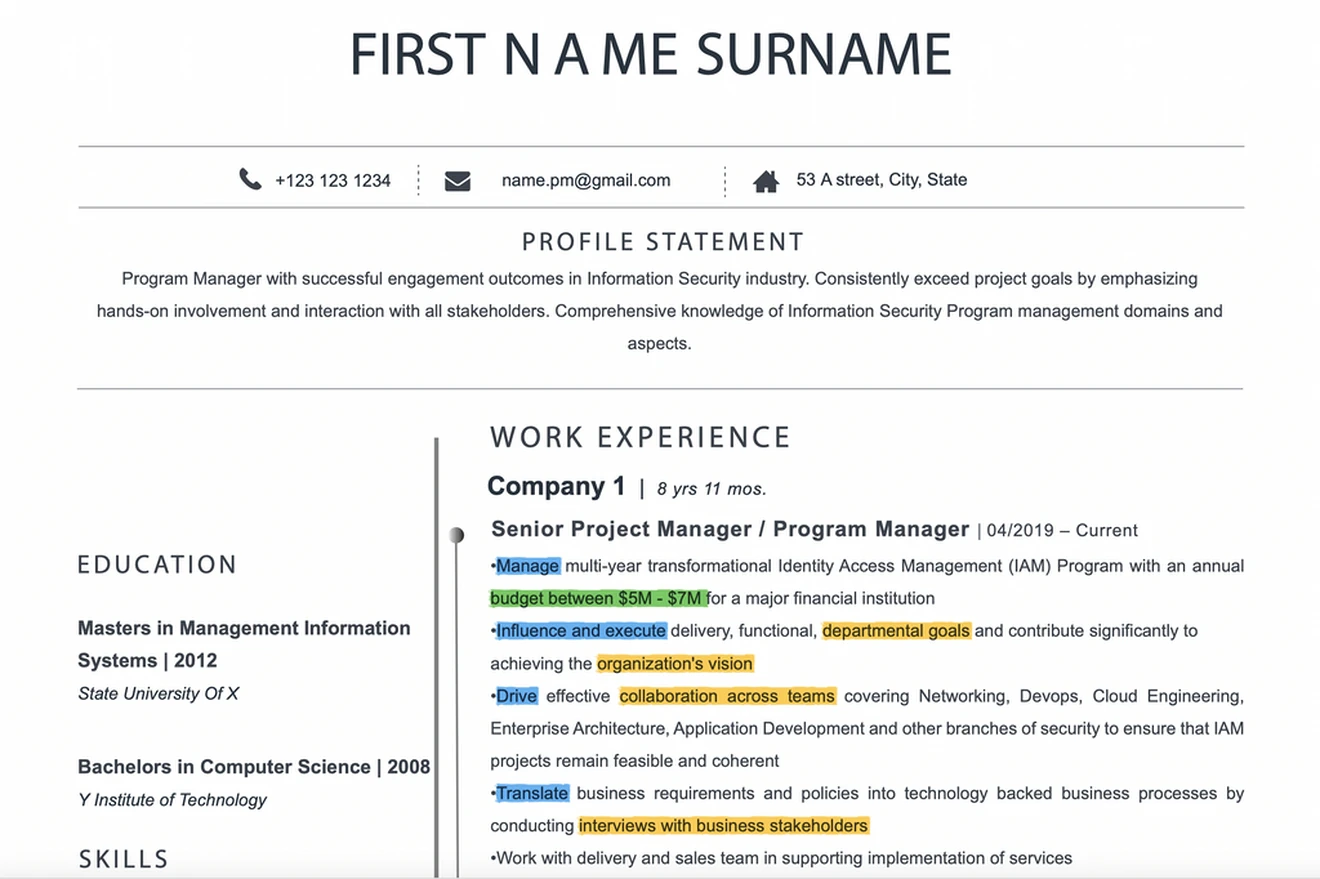
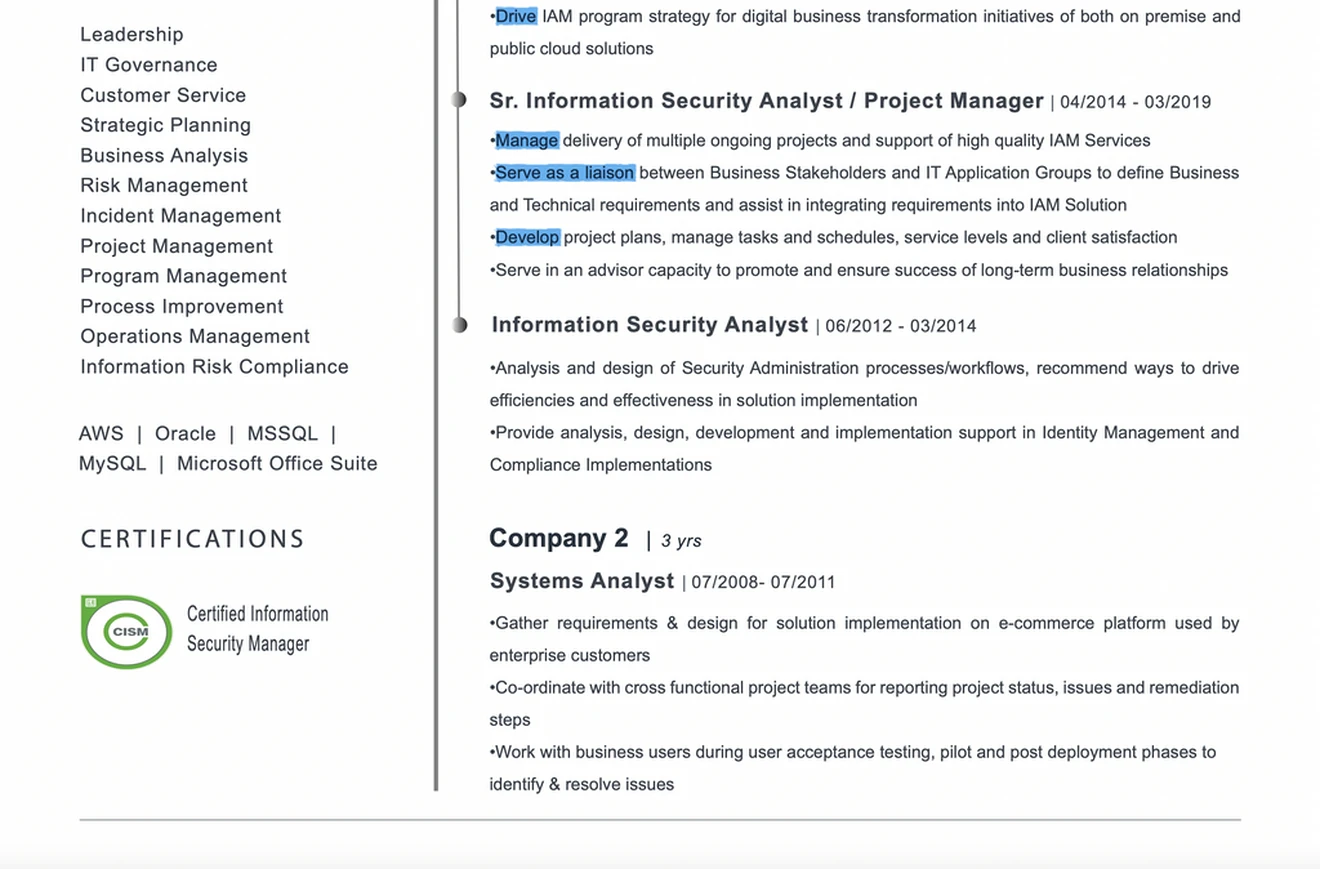
While very different in length and layout, this resume has some similar strengths to the first one:
- Action verbs. Again, the candidate starts sentences with powerful action verbs that demonstrate key TPM skills.
- Quantifying achievements. Although the candidate doesn't include many metrics, he gives the budget he worked with in order to demonstrate the scale of his achievements.
- Key skills for the role. The candidate makes sure that the skills prominent in the job description were placed near the top.
3.3 Microsoft principal technical program manager resume example
“Xavier” is currently a principal TP at Microsoft, and here’s his current resume.
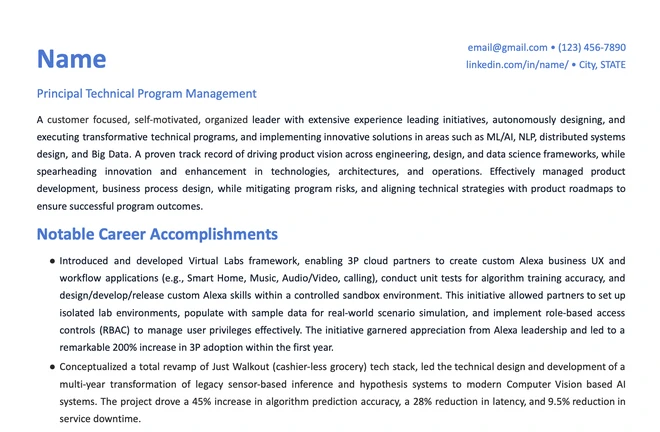



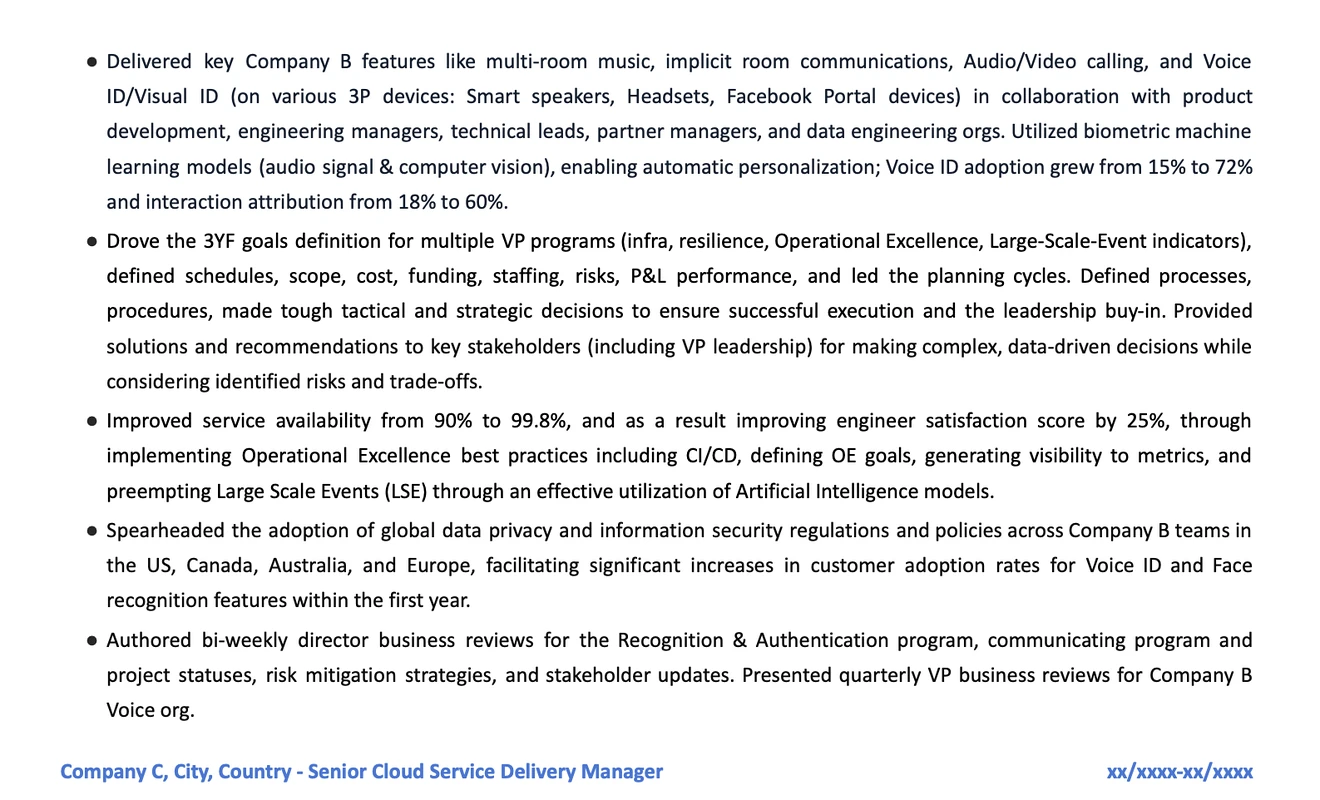
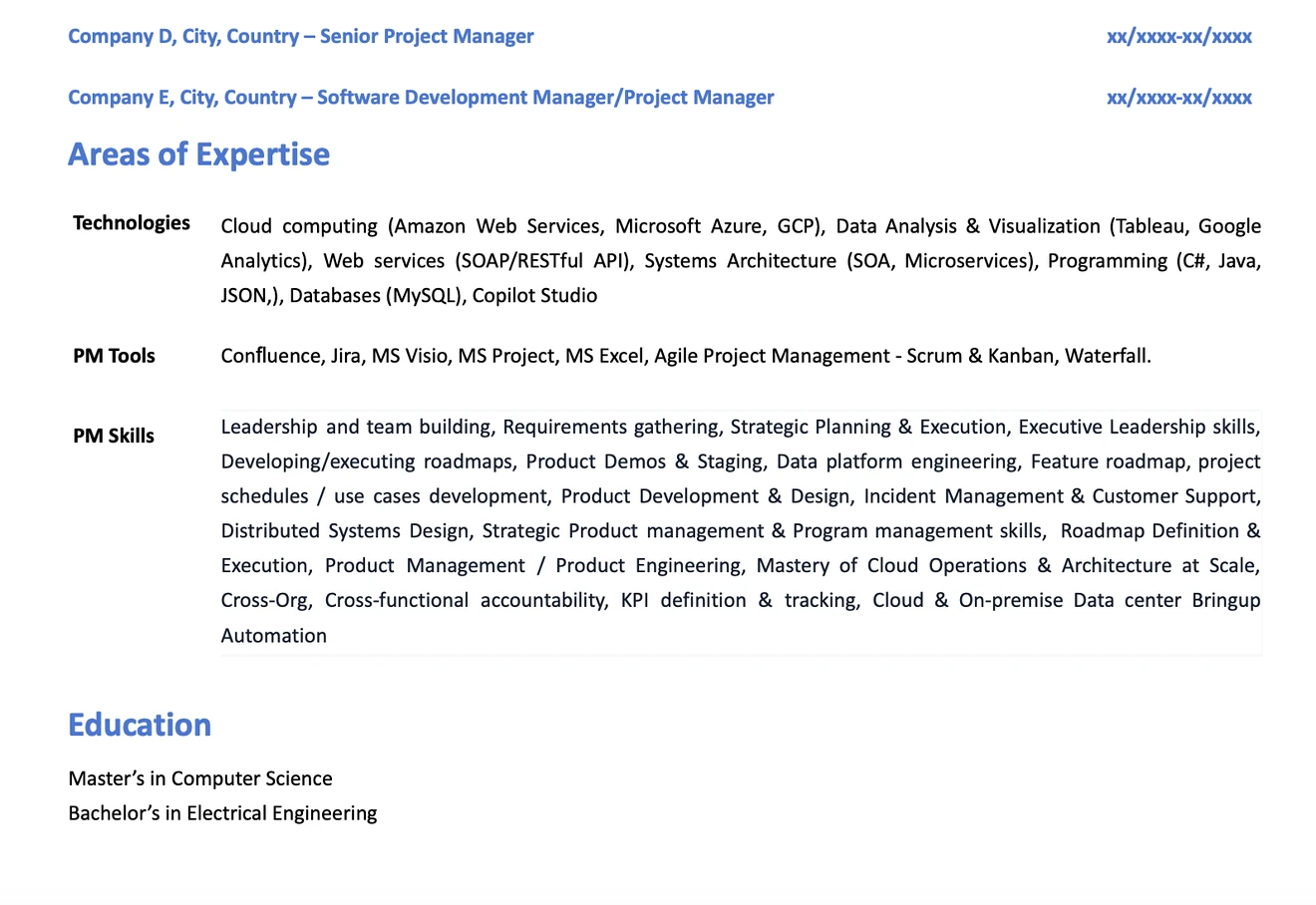
It’s quite a long and detailed resume with narrow margins, but its content is quite impressive and merits the length.
- Career summary. Xavier uses the prime space at the top of his resume to showcase his expertise and notable achievements at a glance.
- Action verbs. Each bullet point starts with a powerful action verb.
- Quantifying achievements. He makes sure to include success metrics and outcomes.
- Recent accomplishments only. He only includes bullet points for his most recent roles, so that he can be as detailed as possible.
3.4 Google senior technical program manager resume example
This is the resume that got “Cacey” a senior technical program manager at Google.
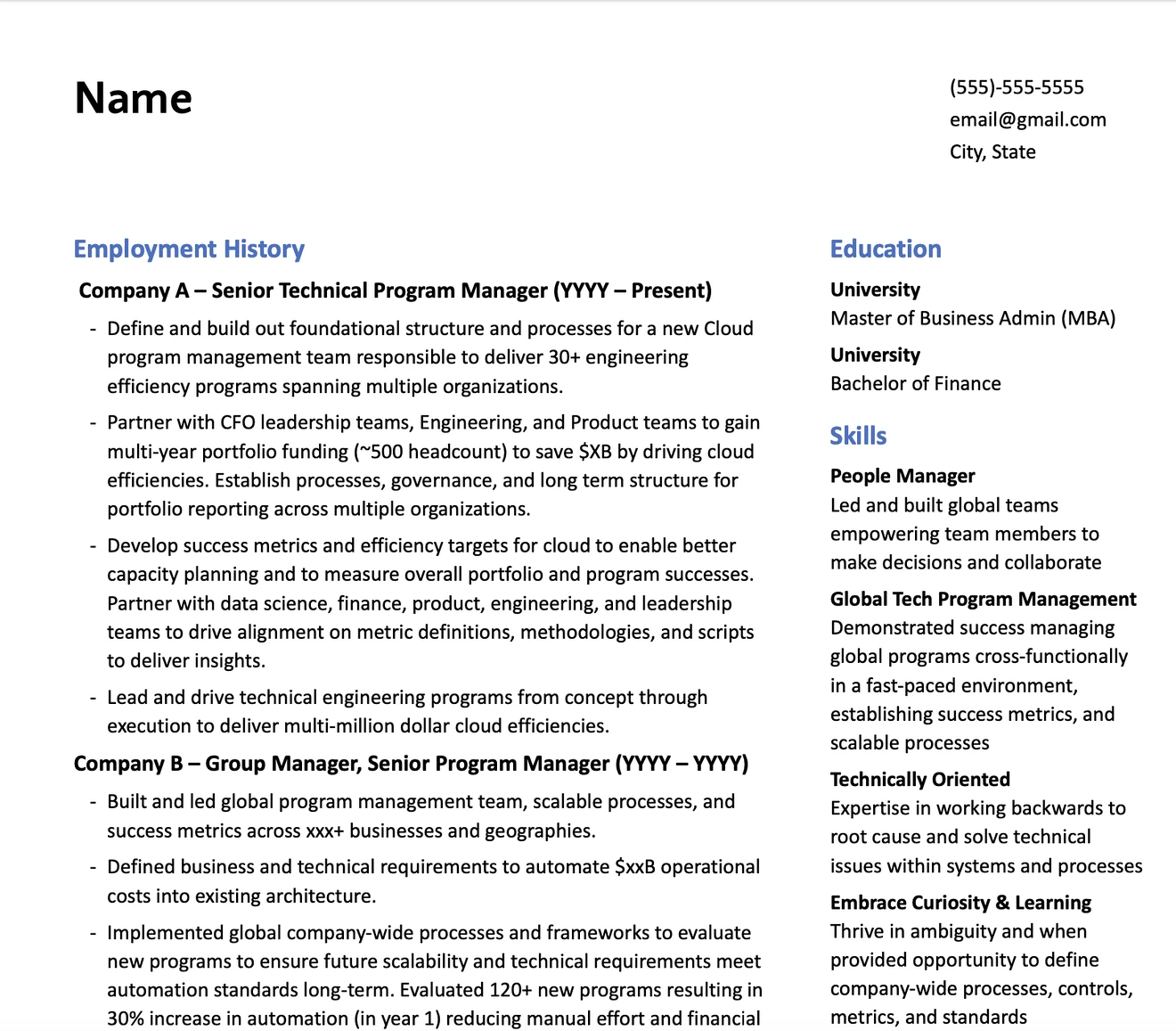


Another comprehensive resume, but shorter at 2 pages. Here are some of her best practices you should adopt:
- Action verbs. The verbs she used are straightforward but impactful: built, developed, collaborated, led.
- Quantified scale and achievements. She uses numbers not just to highlight success metrics but also to emphasize the scale of her work.
- Lists of skills, systems, and tools. She makes sure to have these lists on the first page. So that even when recruiters just scan her resume, they’ll see them at a glance.
3.5 Google program manager resume example
This is the resume that got “Vanessa” a program manager role at Google.




Vanessa’s resume is a classic 2-pager. Here are some of her best practices:
- Professional summary. She starts off her resume with a bullet point list of all her relevant skills, including the systems that she uses, as well as her language proficiencies.
- Action verbs. The verbs she used are straightforward but impactful: delivered, enabled, led.
- Quantified scale and achievements. She makes sure to use numbers to highlight success metrics and emphasize the scale of her work.
- Detailed where relevant. You’ll notice that she devotes a lengthy portion to her career at Amazon to show the depth and breadth of her technical and management experience.
Now you've seen five real Google TPM resumes, it's time to get started on making sure your own is up to scratch.
4. Technical program manager resume template↑
Unlike the examples listed above, this is not a real TPM resume.
Instead, it's an amalgamation of the many high-quality resumes that candidates have shared with us before going on to work at Google, Meta, Amazon, etc.
It belongs to an imaginary mid-level TPM called Gene, but you can follow the overall structure no matter what your level is.
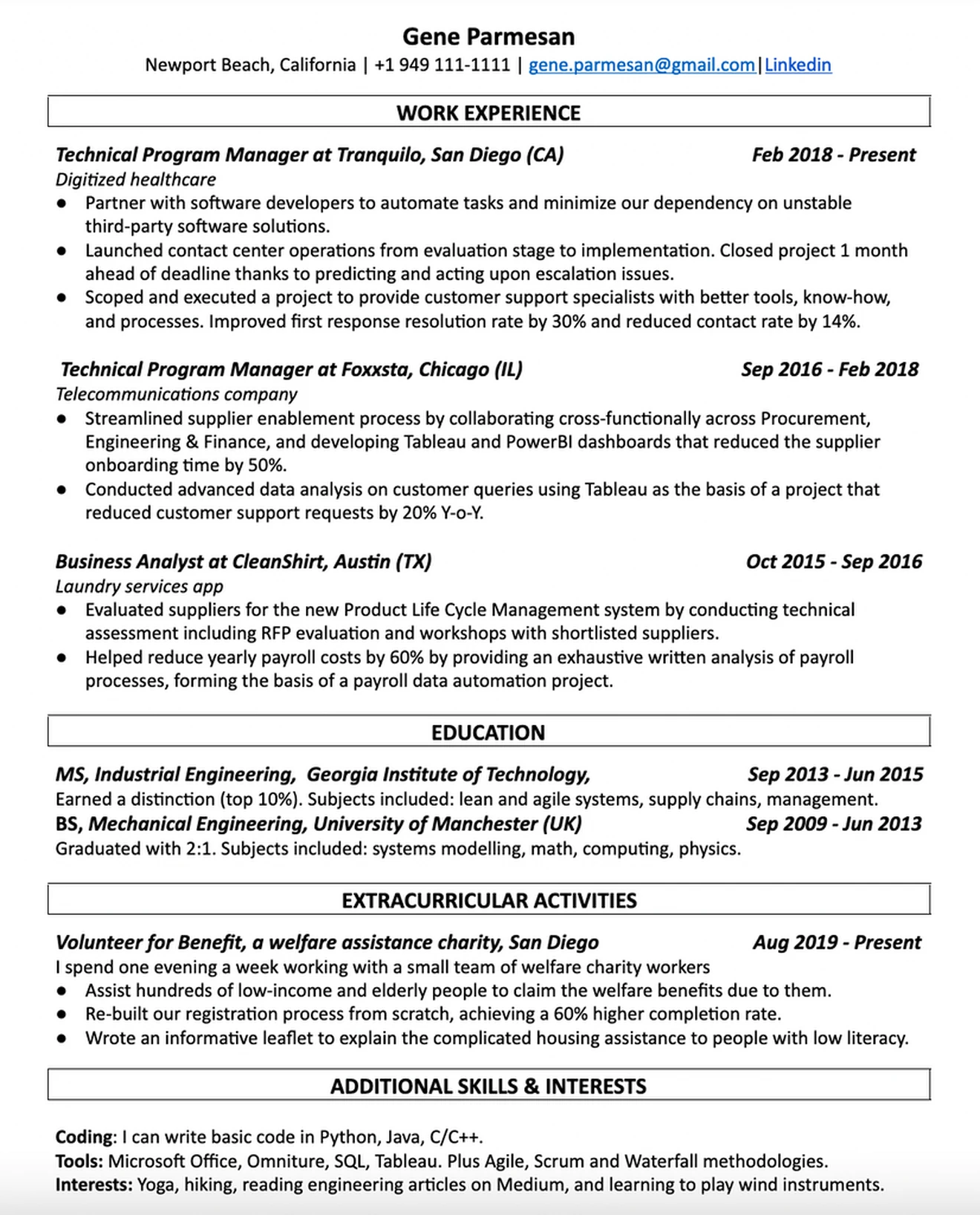
Click here to download the sample TPM resume
5. How to write a technical program manager resume↑
Now you’ve seen examples of what you should be aiming for, as well as some key tips. Let’s go through the resume-building process, step-by-step.
5.1 Study your target company and job description
Before you start writing or editing your TPM resume, our tip is that you do some research.
Find the job specification, read it thoroughly, and use it to shape your resume in the following ways:
- Work out the type of TPM the job description is looking for. Which TPM skills will be most crucial for the role? Prepare to adapt your resume’s content accordingly.
- Zoom in on a few of the responsibilities. Determine which are the most important. Search for examples from your past that demonstrate experience in doing the same thing or something very similar. Find the numbers to back it up, where possible.
- Take note of the language used in the job description so you can, where appropriate, match specific verbs and phrases.
- Research the company. For example, imagine you’re targeting a TPM role at Meta. Meta has 5 core values, so you’d want to make sure that your resume transmits these values too. That might mean including a volunteering activity under Interests to show that you like to "build social value." Do the same if you’re applying for Google or Amazon.
Does all this mean you’ll need a different iteration of your resume for every TPM job you target? Ideally, yes, but there will be a lot of overlap, so usually you’ll only need to make a few strategic edits.
Right, once you’ve done the research, you’ll be ready to start writing.
5.2 Choose a layout
The design of your resume should have one objective: to convey as much information as possible in a way that is clear, easy to digest, and professional.
Use our sample resume as your template, and you’ve already achieved that!
For creative roles, having a resume with a unique design might help catch recruiters’ attention. But for roles like TPM, it might just be a distraction, so it’s best to stick to basic layouts.
Another area of debate is length. Should you always stick to just one page?
The answer is no, not necessarily. If you’re an experienced TPM, it’s fine to have two pages. Just make sure all the content you’re including is strong and relevant to the role.
We can confirm this because many of the candidates who use our coaching service got their FAANG interviews using two-page resumes.
However, if you’ve only been working for a few years or you’ve recently graduated, we strongly recommend sticking to a single page.
5.3 Choose your sections
We recommend using the following section layout for a TPM resume.
The order of the sections and titles is open to debate, but we know that this approach works for companies such as Google, Meta, and Amazon, for both junior and experienced candidates.
- Personal information
- Work experience
- Education
- Extracurricular
- Skills & interests
You may want to tweak the order. For example, if you’ve just graduated or have just a year or two of experience, Google recommends starting with your education section.
5.4 Start writing
The good news is, you don’t have to get it perfect the first time. A strong resume is usually one that is rewritten and tweaked multiple times.
We’ve spoken to tech recruiters to get guidance on how to write each section. Let’s take a look.
5.4.1 Personal details
This section is not the place to try and impress. Just make sure you get your key details across as concisely as possible.
DO:
- Use a bigger font for your name than for the rest of the section to make it stand out
- Include your name, email address, phone number, city/county you live in/remote or hybrid work preference
- Ideally, include a link to your LinkedIn profile (or GitHub if you have an engineering background)
DON’T:
- Title this section. It’s not necessary in this type of layout, so save the space
- Include a street address, it’s unnecessary and unsafe
- Include a photo, date of birth, or gender, unless specifically requested to do so
- Label each piece of information, e.g., “email:”, “tel:”, etc. It’s obvious what they are, so save the space
5.4.2 Work experience section
This is probably the most important part of your resume to get right, and the easiest to get wrong.
Many candidates think that their work experience speaks for itself, and simply list their role and a few of their main responsibilities.
However, we recommend a much more powerful approach.
Instead of listing responsibilities, you need to talk about actions. This means starting each bullet point with an action verb.
These verbs should relate to the seven skills from Section 2 that companies look for in TPM resumes (Program management, Facilitation, Engineering, System design, Data analysis, Leadership, Communication).
"Executed," "Unblocked," "Led," and "Delivered" are some good examples of such verbs.
Choosing actions that are relevant to one of the seven technical program manager essential skills will also mean that your resume contains the keywords that recruiters (and sometimes ATS) will be looking for.
You should also focus on the results of what you did and quantify them as much as possible to highlight the tangible contributions you have made.
Ex-Google SVP Lazlo Bock talks about a common method for doing this that you might find helpful, called the “X, Y, Z” formula.
Finally, balance is also important. Because a technical program manager role is quite multi-faceted, it’s important to demonstrate a range of skills in the work experience section.
DO:
- Use reverse chronological order, putting the most recent employment at the top
- Use present tense verbs (e.g., "Lead, Coordinate, Execute") in your current position (except for completed achievements) and past tense verbs for past positions (e.g., "Led, Coordinated, Executed")
- Describe your actions and what they achieved
- Include metrics to quantify what your actions achieved, where possible
- Focus on your previous roles’ impact and complexity
- Study the language of the job description and, where appropriate, match it
- Make sure you’ve naturally included several relevant keywords
- Demonstrate a balance of skills
DON’T:
- Be shy and humble. Now is not the time!
- Just put your responsibilities
- Be vague
- Go so overboard with numbers that it looks like a math problem. It still needs to be easy to read.
- Include lots of buzzwords and company jargon just for the sake of it
5.4.3 Education section
This section should be extremely concise and clear. Hopefully, your educational achievements can do the talking for you, as all you can really do here is present the necessary information with the right level of detail.
Note that if you have recently graduated and only have internship experiences, this section should follow the Personal Information section, and you may want to go into a bit more detail. Otherwise, you can include it after work experience.
Follow the tips below to make sure you get it just right.
DO:
- If you have multiple degrees (e.g., a BA and an MBA), you should write a subsection like the one above for each degree, starting with your highest level of education first (e.g., your MBA)
- For each degree, include the name of the degree, university, and dates in the headline. If you’re a recent graduate, you can also list any subjects you have taken that are relevant to TPM.
- List your grades (e.g., GPA) as well as results of other standardized tests you have taken (e.g., SAT, GMAT, etc.) that demonstrate your intellect
- Detail any awards and scholarships you received at the university level, and most importantly, how competitive they were (e.g., two awards for 1,000 students)
- If you don’t have much tech work experience, include tech bootcamps (e.g., General Assembly) and link to your projects, or online courses (e.g., Udacity)
DON’T:
- Panic if you don't have a degree. You don’t have to have gone to college to get into a FAANG company. Instead, put your high school grades and any relevant educational qualifications you gained after school
- Include high school experience if you've already graduated
- Include your thesis / dissertation unless you're a fairly recent graduate. In this case, summarize the topic in a way that's VERY easy to understand
5.4.4 Extracurricular section
TPM roles require a breadth of skills, and it can be difficult to demonstrate all of them through your work experience. The extracurricular section is, therefore, a great opportunity to cover these skills.
It can be particularly useful in demonstrating leadership skills, especially if you haven’t yet had much opportunity to lead in a work situation.
Note: If you’re applying to Google, you should consider calling this section “Leadership & Awards” to fit in with their recommended resume structure. Obviously, you’ll need to make sure that the content demonstrates those two things.
The extracurricular section is more important for recent graduates than experienced hires.
But even for TPMs with a lot of impressive work experience to fit in, talking briefly about your personal projects can add a whole new dimension to the “you” on your resume.
Stuck for ideas? Here are a few different types of activities you could write about (not exhaustive):
- Side businesses: if you have set up a side business, you should mention it along with the number of users and/or revenue you have achieved
- Coding projects: if you're not a developer but have built simple web apps to teach yourself to code, this is the place to mention it
- Writing/design: if you enjoy writing or design and have a blog where you show your work, share it in this section
- Meetups/events: be sure to mention if you have organized meetups or events in the past, as this is a great way to highlight leadership skills
- University clubs/sports teams: if you are a recent graduate and have held a position in a university club (e.g., Entrepreneur club) or were part of a sports team, then this is also a great thing to include
However, you simply might not have any recent and relevant extracurricular activities worth including. This is often the case for parents who have young children.
If that’s the case, you can leave out this section. After all, if it’s not going to make you shine, there’s no point including it.
Ready to write the extracurricular section? Here are the remaining tips you need to know.
DO:
- Use this section to demonstrate relevant skills, such as leadership
- As with work experience, try and include actions and achievements, and quantify them
DON’T:
- Put a hyphen in the title: "Extracurricular” is all one word
- Capitalize “university” unless you’re using it as a proper noun (e.g, “Oxford University”)
- Give very outdated examples. If you graduated seven+ years ago, there shouldn’t really be university examples there.
5.4.5 Additional skills & interests section
Technical program managers need to be adept at using a wide range of tools, methodologies, and technologies. This section gives you the opportunity to list yours.
You should list any programming languages (e.g., HTML, CSS, JS, Python, etc.), as well as relevant tools (e.g., Jira, Sketch, Tableau, etc.) and program management methodologies that you’re familiar with.
List down your foreign language proficiencies. Recruiters for big tech companies value language skills in TPMs.
If you have room, add interests that showcase your personality.
However, if you’ve already covered your personal interests in the Extracurricular section (or if you’ve been so career-focused that you simply don’t have any!), then you can change this section to just “Additional skills.”
Take a look at our additional tips below.
DO:
- List things in sentences rather than lots of bullets, which take up too much vertical space
DON’T:
- Include generic, uninteresting things that everyone likes doing, like “watching Netflix” or “hanging out with friends,” as hobbies
5.5 Proofreading and feedback
Your resume reflects your professionalism, so don’t skip this step.
Use the grammar checking tool in Word or Google Docs, and proofread until it’s perfect.
This is harder than it sounds. Multiple reviews and tweaking after the initial proofread can easily create new hard-to-spot errors. The only solution is to proofread again.
The two most recommended formats for resumes are PDF and DOCX. But best to check which format the job description requires.
Ines says that some ATS still have trouble with other file formats, so if the job description doesn’t specify, DOCX might be a better file format option. Before sending it, you should check that it opens properly (with the correct formatting) on a Mac or PC.
Receiving feedback is also important. Share it with a friend or partner, and they’ll be very likely to see mistakes that you haven’t noticed.
Of course, if you can share it with an experienced TPM, that’s even better.
DO:
- Proofread from top to bottom and then read it in reverse to check spelling
- If you’ve tweaked it, proofread again before sending
- Check that the file opens properly on Mac and PC
- Get feedback on it before sending
DON’T:
- Send it with typos. Your resume reflects your attention to detail.
6. Your TPM resume checklist↑
Almost ready to send your resume? Use this checklist to make sure you’re following the best practices we’ve recommended above.
If you can answer “Yes” to every question, then you’re ready to send it.
General
- Does your resume present you as the type of TPM the job description is looking for?
Layout
- Is it just one page? If not, do you have the experience to merit 2 pages?
- Is the formatting 100% consistent and neat?
- Is there enough white space to breathe?
Personal information
- Have you checked that your contact details are correct?
Work experience
- Have you talked about your actions rather than your responsibilities?
- Have you quantified the impact of your actions?
- Have you demonstrated the seven TPM skills? (Program management, Facilitation, Engineering, System design, Data analysis, Leadership, Communication)
- Have you got the tenses correct?
- Have you removed company jargon and acronyms?
Extracurricular
- If you graduated >5 years ago, are your examples post-university?
Skills & interests
- Have you listed all the programming languages and tools you’re familiar with?
- Do your interests make you stand out from the crowd in some way?
Proofreading and feedback
- Have you proofread since you last edited it?
- Have you received any feedback on your resume and updated it?
- Have you saved it in the file format specified in the job description?
- Have you checked to make sure it displays correctly on all devices?
Did you say “Yes” to every question? Well done!
If you’ve used all the tips in this article, then your resume should be in good condition and will give you a fighting chance of getting an interview at FAANG or any other top tech company.
To increase your chances of getting your resume noticed, Ines’s advice is to apply to new job postings so your resume is one of the first in the pile.
She explains that once interviewing has started, getting noticed gets harder, even with a top-notch resume.
She says, “I always recommend people do a little bit of job searching every day to see what's new and apply to job postings as close to the posting date as possible.”
Managed to get past the resume screening stage already? Check out our interview prep guide for the Google technical program manager role here.
7. Is your TPM resume truly outstanding?
If you want to get a job in big tech, having a resume that's "fine" may not be enough.
To get your TPM resume from "fine" to "outstanding" usually requires feedback from someone who really knows their stuff. Like an ex-recruiter or manager at one of the top companies.









